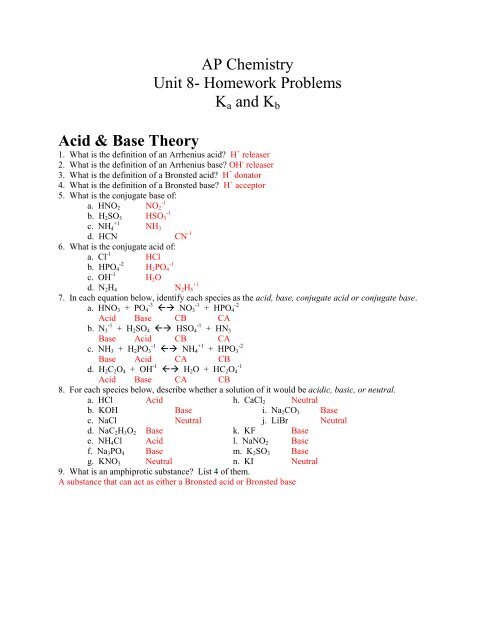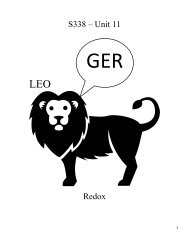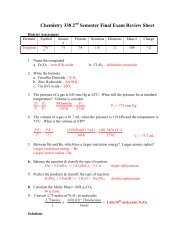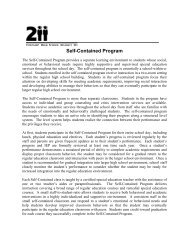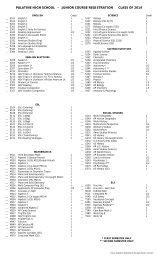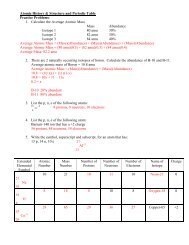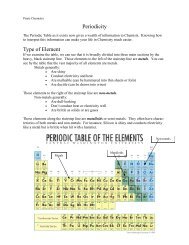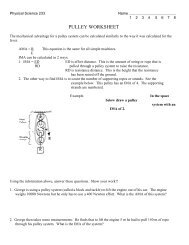AP Chemistry Unit 8- Homework Problems Ka and Kb Acid & Base ...
AP Chemistry Unit 8- Homework Problems Ka and Kb Acid & Base ...
AP Chemistry Unit 8- Homework Problems Ka and Kb Acid & Base ...
You also want an ePaper? Increase the reach of your titles
YUMPU automatically turns print PDFs into web optimized ePapers that Google loves.
<strong>AP</strong> <strong>Chemistry</strong><br />
<strong>Unit</strong> 8- <strong>Homework</strong> <strong>Problems</strong><br />
K a <strong>and</strong> K b<br />
<strong>Acid</strong> & <strong>Base</strong> Theory<br />
1. What is the definition of an Arrhenius acid? H + releaser<br />
2. What is the definition of an Arrhenius base? OH - releaser<br />
3. What is the definition of a Bronsted acid? H + donator<br />
4. What is the definition of a Bronsted base? H + acceptor<br />
5. What is the conjugate base of:<br />
a. HNO 2 NO 2<br />
-1<br />
b. H 2 SO 3<br />
-1<br />
HSO 3<br />
+1<br />
c. NH 4 NH 3<br />
d. HCN CN -1<br />
6. What is the conjugate acid of:<br />
a. Cl -1 HCl<br />
-2<br />
b. HPO 4<br />
-1<br />
H 2 PO 4<br />
c. OH -1 H 2 O<br />
d. N 2 H 4<br />
+1<br />
N 2 H 5<br />
7. In each equation below, identify each species as the acid, base, conjugate acid or conjugate base.<br />
a. HNO 3 + PO -3 4 NO -1 3<br />
-2<br />
+ HPO 4<br />
<strong>Acid</strong> <strong>Base</strong> CB CA<br />
b. N -1 3 + H 2 SO 4 HSO -1 4 + HN 3<br />
<strong>Base</strong> <strong>Acid</strong> CB CA<br />
c. NH 3 + H 2 PO -1 3 NH +1 4<br />
-2<br />
+ HPO 3<br />
<strong>Base</strong> <strong>Acid</strong> CA CB<br />
d. H 2 C 2 O 4 + OH -1 -1<br />
H 2 O + HC 2 O 4<br />
<strong>Acid</strong> <strong>Base</strong> CA CB<br />
8. For each species below, describe whether a solution of it would be acidic, basic, or neutral.<br />
a. HCl <strong>Acid</strong> h. CaCl 2 Neutral<br />
b. KOH <strong>Base</strong> i. Na 2 CO 3 <strong>Base</strong><br />
c. NaCl Neutral j. LiBr Neutral<br />
d. NaC 2 H 3 O 2 <strong>Base</strong> k. KF <strong>Base</strong><br />
e. NH 4 Cl <strong>Acid</strong> l. NaNO 2 <strong>Base</strong><br />
f. Na 3 PO 4 <strong>Base</strong> m. K 2 SO 3 <strong>Base</strong><br />
g. KNO 3 Neutral n. KI Neutral<br />
9. What is an amphiprotic substance? List 4 of them.<br />
A substance that can act as either a Bronsted acid or Bronsted base
Auto-Ionization of water, pH, <strong>and</strong> strong acids<br />
1. What is the equation for the auto-ionization of water? 2 H 2 O (l) H 3 O +1 (aq) + OH -1 (aq)<br />
2. What is the equation for K w <strong>and</strong> what is its value? K w = [H 3 O + ][OH -1 ] = 1x10 -14<br />
3. Because the pH scale is a logarithmic scale, every change in 1 is really a change in how much? 10<br />
4. Using the pH square <strong>and</strong> the equations learned in class, fill in the blank spots in the chart below:<br />
pH [H 3 O +1 ] [OH -1 ] pOH<br />
3.5 3.16x10 -4 3.16x10 -11 10.5<br />
8.04 9.2x10 -9 1.10x10 -6 5.96<br />
3.67 2.14x10 -4 4.7x10 -11 10.33<br />
5.8 1.58x10 -6 6.31x10 -9 8.2<br />
5. According to the leveling effect:<br />
a. What is the strongest acid species in water? H 3 O +1<br />
b. What is the strongest base species in water? OH -1<br />
6. What is the % dissociation of strong acids <strong>and</strong> bases in water? 100%<br />
7. List 6 strong acids. HCl, HBr, HI, HNO 3 , HClO 4 , H 2 SO 4<br />
8. List 6 strong bases. LiOH, NaOH, KOH, RbOH, CsOH, Ba(OH) 2 , Sr(OH) 2<br />
Weak acids & bases, K a , K b , <strong>and</strong> pH<br />
1. How are weak acids <strong>and</strong> bases different from strong ones? Weak acids dissociate
6. For a 0.055 M solution of HClO (K a = 2.9x10 -8 ) calculate:<br />
a. pH<br />
HA (aq) + H 2 O (l) H 3 O +1 (aq) + A -1 (aq)<br />
I 0.055 0 0<br />
C -x +x +x<br />
E 0.055 x x<br />
2.9x10 -8 = x 2 /0.055 x = 3.99x10 -5 pH = -log (3.99x10 -5 ) = 4.40<br />
b. % dissociation<br />
3.99x10 -5 x 100% = 0.0725%<br />
0.055<br />
7. For a 0.0034 M solution of C 5 H 5 N (K b = 1.7x10 -9 ) calculate:<br />
a. pH<br />
B (aq) + H 2 O (l) OH -1 (aq) + HB +1 (aq)<br />
I 0.0034 0 0<br />
C -x +x +x<br />
E 0.0034 x x<br />
1.7x10 -9 = x 2 /0.0034 x = 2.40x10 -6 pOH = -log (2.40x10 -6 ) = 5.62 pH = 8.38<br />
b. % dissociation<br />
2.40x10 -6 x 100% = 0.071%<br />
0.0034<br />
8. For a 0.15 M solution of H 2 C 6 H 6 O 6 (K a1 = 8x10 -5 K a2 = 1.6 x10 -12 ) calculate:<br />
a. pH<br />
H 2 A (aq) + H 2 O (l) H 3 O +1 (aq) + HA -1 (aq)<br />
I 0.15 0 0<br />
C -x +x +x<br />
E 0.15 x x<br />
8x10 -5 = x 2 /0.15 x = 3.46x10 -3 pH = -log (3.46x10 -3 ) = 2.46<br />
b. Equilibrium concentrations of:<br />
-1<br />
i) HC 6 H 6 O 6 x = 3.46x10 -3<br />
-2<br />
ii) C 6 H 6 O 6 K a2 = 1.6x10 -12<br />
9. For a 0.025 M solution of diprotic base, B (K b1 = 4x10 -6 , K b2 = 8x10 -10 ) calculate:<br />
a. pH<br />
B (aq) + H 2 O (l) OH -1 (aq) + HB +1 (aq)<br />
I 0.025 0 0<br />
C -x +x +x<br />
E 0.025 x x<br />
4x10 -6 = x 2 /0.025 x = 3.16x10 -4 pOH = -log (3.16x10 -4 ) = 3.5 pH = 10.5<br />
b. Equilibrium concentrations of:<br />
i) HB + x = 3.16x10 -4<br />
ii) H 2 B +2 K b2 = 8x10 -10
<strong>Acid</strong>-<strong>Base</strong> Interactions<br />
Strong-Strong<br />
1. What is the pH when 50 mL of 0.1 M HCl is mixed with 50 mL of 0.1 M NaOH?<br />
<strong>Acid</strong> = (50/100)(0.1 M) = 0.05 M<br />
<strong>Base</strong> = (50/100)(0.1 M) = 0.05 M<br />
Equal amounts of strong acid/base so should be neutral<br />
H 3 O +1 (aq) + OH -1 (l) 2 H 2 O<br />
I 0.05 0.05<br />
C -0.05 -0.05<br />
E 0 0<br />
pH = 7<br />
2. What is the pH when 250 mL of 0.2 M HNO 3 is mixed with 500 mL of 0.1 M KOH?<br />
<strong>Acid</strong> = (250/750)(0.2 M) = 0.0667 M <strong>Base</strong> = (500/750)(0.1 M) = 0.0667 M<br />
Equal amounts of strong acid/base so should be neutral<br />
H 3 O +1 (aq) + OH -1 (l) 2 H 2 O<br />
I 0.0667 0.0667<br />
C -0.0667 -0.0667<br />
E 0 0<br />
pH = 7<br />
3. What is the pH when 100 mL of 0.001 M HBr is mixed with 50 mL of 0.001 M NaOH?<br />
<strong>Acid</strong> = (100/150)(0.001 M) = 6.67x10 -4 M<br />
<strong>Base</strong> = (50/150)(0.001 M) = 3.33x10 -4 M<br />
More acid than base so should be acidic<br />
H 3 O +1 (aq) + OH -1 (l) 2 H 2 O<br />
I 6.67x10 -4 3.33x10 -4<br />
C -3.33x10 -4 -3.33x10 -4<br />
E 3.33x10 -4 0<br />
pH = -log (3.33x10 -4 ) = 3.47<br />
4. What is the pH when 40 mL of 0.01 M HI is mixed with 120 mL of 0.008 M CsOH?<br />
<strong>Acid</strong> = (40/160)(0.01 M) = 0.0025 M <strong>Base</strong> = (120/160)(0.008 M) = 0.006 M<br />
More base than acid so should be basic<br />
H 3 O +1 (aq) + OH -1 (l) 2 H 2 O<br />
I 0.0025 0.006<br />
C -0.0025 -0.0025<br />
E 0 0.0035<br />
pOH = -log (0.0035) = 2.46 pH = 11.54
5. What is the pH when 50 mL of 0.0025 M H 2 SO 4 is mixed with 75 mL of 0.0040 M LiOH?<br />
<strong>Acid</strong> = 2*(50/125)(0.0025 M) = 0.0020 M<br />
<strong>Base</strong> = (75/125)(0.0040 M) = 0.0024 M<br />
More base than acid so should be basic<br />
H 3 O +1 (aq) + OH -1 (l) 2 H 2 O<br />
I 0.0020 0.0024<br />
C -0.0020 -0.0020<br />
E 0 0.0004<br />
pOH = -log (0.0004) = 3.4 pH = 10.6<br />
6. What is the pH when 20 mL of 0.00050 M HClO 4 is mixed with 20 mL of 0.00040 M Ba(OH) 2 ?<br />
<strong>Acid</strong> = (20/40)(0.00050 M) = 0.00025 M <strong>Base</strong> = 2* (20/40)(0.0004 M) = 0.0004 M<br />
More base than acid so should be basic<br />
H 3 O +1 (aq) + OH -1 (l) 2 H 2 O<br />
I 0.00025 0.0004<br />
C -0.00025 -0.00025<br />
E 0 0.00015<br />
pOH = -log (0.00015) = 3.8 pH = 10.2<br />
Strong-Weak<br />
7. What is the pH when 25 mL of 0.25 M HCl is mixed with 25 mL of 0.25 M NH 3 ? (K b = 1.8x10 -5 )?<br />
<strong>Acid</strong> = (25/50)(0.25 M) = 0.125 M <strong>Base</strong> = (25/50)(0.25 M) = 0.125 M<br />
Equal amounts of strong acid/weak base so should be acidic<br />
Shortcut hint- Equivalence point of a strong acid weak base gives a normal K a problem<br />
(you can skip the actual rxn <strong>and</strong> go straight to K a of conj. acid of weak base)<br />
ACTUAL RXN- GOES ALMOST ALL THE WAY (water is a product; math is bad)<br />
H 3 O +1 (aq) + NH 3 (aq) H 2 O (l) + NH +1 4 (aq)<br />
I 0.125 0.125 0<br />
C -0.125 -0.125 +0.125<br />
E 0 0 0.125<br />
NOW FLIP RXN AND DO K a (K a = 1x10 -14 /1.8x10 -5 ) = 5.56x10 -10<br />
NH +1 4 (aq)+ H 2 O (l) H 3 O +1 (aq) + NH 3 (aq)<br />
I 0.125 0 0<br />
C -x +x +x<br />
E 0.125 x x<br />
5.56x10 -10 = x 2 /0.125 x = 8.33x10 -6 pH = -log (8.33x10 -6 ) = 5.08
8. What is the pH when 20 mL of 0.020 M HNO 3 is mixed with 20 mL of 0.030 M C 6 H 5 NH 2 (K b = 4x10 -10 )?<br />
<strong>Acid</strong> = (20/40)(0.02 M) = 0.01 M <strong>Base</strong> = (20/40)(0.030 M) = 0.015 M<br />
Not at equivalence point. Not at midpoint.<br />
ACTUAL RXN- GOES ALMOST ALL THE WAY (water is a product; math is bad)<br />
H 3 O +1 (aq) + C 6 H 5 NH 2 (aq) H 2 O (l) + C 6 H 5 NH +1 3 (aq)<br />
I 0.01 0.015 0<br />
C -0.01 -0.01 +0.01<br />
E 0 0.005 0.01<br />
NOW FLIP RXN AND DO K a (K a = 1x10 -14 /4x10 -10 ) = 2.5x10 -5<br />
C 6 H 5 NH +1 3 (aq) + H 2 O (l) H 3 O +1 (aq) + C 6 H 5 NH 2 (aq)<br />
I 0.01 0 0.005<br />
C -x +x +x<br />
E 0.01 x 0.005<br />
2.5x10 -5 = x(0.005/0.01) x = 5x10 -5 pH = -log (5x10 -5 ) = 4.30<br />
Shortcut hint- Simple buffer problem. Write K a equation <strong>and</strong> plug in amounts after strong acid is<br />
neutralized (you can skip the actual rxn)<br />
Strong acid: 0.01 M neutralized is turned into a weak acid<br />
Weak base: 0.015 M -0.01 M neutralized by acid so 0.005 left<br />
Now plug straight into 2 nd ICE table above <strong>and</strong> solve<br />
9. What is the pH when 50 mL of 0.040 M NaOH is mixed with 50 mL of 0.040 M HN 3 (K a = 1.9x10 -5 )?<br />
<strong>Base</strong> = (50/100)(0.04 M) = 0.02 M <strong>Acid</strong> = (50/100)(0.04 M) = 0.02 M<br />
Equal amounts of strong base/weak acid so should be basic<br />
ACTUAL RXN- GOES ALMOST ALL THE WAY (water is a product; math is bad)<br />
OH -1 (aq) + HN 3 (aq) H 2 O (l) + N -1 3 (aq)<br />
I 0.02 0.02 0<br />
C -0.02 -0.02 +0.02<br />
E 0 0 0.02<br />
NOW FLIP RXN AND DO K b (K b = 1x10 -14 /1.9x10 -5 ) = 5.26x10 -10<br />
N -1 3 (aq)+ H 2 O (l) OH -1 (aq) + HN 3 (aq)<br />
I 0.02 0 0<br />
C -x +x +x<br />
E 0.02 x x<br />
5.26x10 -10 = x 2 /0.02 x = 3.24x10 -6<br />
pOH = -log (3.242x10 -6 ) = 5.49 pH = 8.51<br />
Shortcut hint- Equivalence point of a strong base weak acid gives a normal K b problem<br />
(you can skip the actual rxn <strong>and</strong> go straight to K b of conj. base of weak acid)
10. What is the pH when 120 mL of 0.0075 M KOH is mixed with 200 mL of 0.0050 M HOCl (K a = 3.5x10 -8 )?<br />
<strong>Base</strong> = (120/320)(0.0075 M) = 0.00281 M <strong>Acid</strong> = (200/320)(0.005 M) = 0.00312 M<br />
Not at equivalence point. Not at midpoint.<br />
ACTUAL RXN- GOES ALMOST ALL THE WAY (water is a product; math is bad)<br />
OH -1 (aq) + HOCl (aq) H 2 O (l) + OCl -1 (aq)<br />
I 0.00281 0.00312 0<br />
C -0.00281 -0.00281 +0.00281<br />
E 0 0.00031 0.00281<br />
NOW FLIP RXN AND DO K b (K b = 1x10 -14 /3.5x10 -8 ) = 2.89x10 -7<br />
OCl -1 (aq) + H 2 O (l) OH -1 (aq) + HOCl (aq)<br />
I 0.00281 0 0.00031<br />
C -x +x +x<br />
E 0.00281 x 0.00031<br />
2.89x10 -7 = x(0.00031/0.00281) x = 2.59x10 -6<br />
pOH = -log (2.59x10 -6 ) = 5.59 pH = 8.41<br />
Shortcut hint- Simple buffer problem. Write K a equation <strong>and</strong> plug in amounts after strong base is<br />
neutralized (you can skip the actual rxn)<br />
Strong base = 0.00281 turns into weak base<br />
Weak acid = 0.00312 neutralized <strong>and</strong> left with 0.00312-0.00281 = 0.00031<br />
So:<br />
HOCl (aq) + H 2 O (l) H 3 O + (aq) + OCl -1 (aq)<br />
I 0.00031 0 0.00281<br />
C -x +x +x<br />
E 0.00031 x 0.00281<br />
3.5x10 -8 = x(0.00281/0.00031) x = 3.86x10 -9 pH = 8.41<br />
Midpoint<br />
11. What is the pH when 25 mL of 0.050 M HCl is mixed with 50 mL of 0.050 C 5 H 5 N (K b = 1.5x10 -9 )?<br />
acid = (25/75)(0.050 M) = 0.0166 M base = (50/75)(0.050 M) = 0.0333 M<br />
At midpoint! (Half as much strong acid as base)<br />
pH = p<strong>Ka</strong> so K a = (1x10 -14 /1.5x10 -9 ) = 6.67x10 -6 so pH = - log (6.67x10 -6 ) = 5.18<br />
12. What is the pH when 40 mL of 0.80 M NaOH is mixed with 80 mL of 0.8 M HNO 2 (K a = 4.5x10 -4 )?<br />
base = (40/120)(0.80 M) = 0.266 M acid = (80/120)(0.80 M) = 0.5333 M<br />
At midpoint! (Half as much strong base as acid)<br />
pH = p<strong>Ka</strong> so pH = - log (4.5x10 -4 ) = 3.35
13. What is the pH when 30 mL of 0.006 M HNO 3 is mixed with 30 mL of 0.012 M (CH 3 ) 3 N (K b = 7.4x10 -5 )?<br />
acid = (30/60)(0.006 M) = 0.003 M base = (30/60)(0.012 M) = 0.006 M<br />
At midpoint! (Half as much strong acid as base)<br />
pH = p<strong>Ka</strong> so K a = (1x10 -14 /7.4x10 -5 ) = 1.35x10 -10 so pH = - log (1.35x10 -10 ) = 9.87<br />
14. What is the pH when 100 mL of 0.0078 M KOH is mixed with 100 mL of 0.0156 M C 6 H 5 CO 2 H (K a = 6.3x10 -5 )<br />
base = (100/200)(0.0078 M) = 0.0039 M<br />
acid = (100/200)(0.0156 M) = 0.0078 M<br />
At midpoint! (Half as much strong base as acid)<br />
pH = p<strong>Ka</strong> so pH = - log (6.3x10 -5 ) = 4.2<br />
K sp <strong>and</strong> pH<br />
1. What is the pH of a saturated solution of Mn(OH) 2 K sp = 1.9x10 -13 ?<br />
K sp = [Mn +2 ][OH -1 ] 2 1.9x10 -13 = 4x 3<br />
x= 3.67x10 -5 so [OH -1 ] = 7.32 x10 -5 so pOH = 4.14 so pH = 9.86<br />
2. What is the pH of a saturated solution of Ca(OH) 2 K sp = 5.5x10 -5 ?<br />
K sp = [Ca +2 ][OH -1 ] 2 5.5x10 -5 = 4x 3<br />
x= 0.0240 so [OH -1 ] = 0.0480 so pOH = 1.32 so pH = 12.68<br />
3. At what pH will a 0.0075 M solution of Mg(OH) 2 begin to form a precipitate (K sp = 5.6x10 -12 )?<br />
K sp = [Mg +2 ][OH -1 ] 2 5.6x10 -12 = [0.0075][x] 2<br />
x= 2.73x10 -5 so [OH -1 ] = 2.73x10 -5 so pOH = 4.56 so pH = 9.44<br />
4. At what pH will a 0.00042 M solution of Pb(OH) 2 begin to form a precipitate (K sp = 1.4x10 -15 )?<br />
K sp = [Pb +2 ][OH -1 ] 2 1.4x10 -15 = [0.00042][x] 2<br />
x= 1.83x10 -6 so [OH -1 ] = 1.83x10 -6 so pOH = 5.74 so pH = 8.26
Titration Curves<br />
1. Draw a titration curve of a strong base being titrated by a strong acid. Be sure to label a pH of 7 in the<br />
appropriate spot.<br />
pH<br />
7<br />
mL acid added<br />
2. Draw a titration curve of a strong acid being titrated by a strong base. Be sure to label a pH of 7 in the<br />
appropriate spot.<br />
pH<br />
7<br />
mL acid added<br />
3. Draw a titration curve of a weak base being titrated by a strong acid. Be sure to label a pH of 7 in the<br />
appropriate spot.<br />
pH<br />
7<br />
mL acid added
4. Draw a titration curve of a weak acid being titrated by a strong base. Be sure to label a pH of 7 in the<br />
appropriate spot.<br />
pH<br />
7<br />
mL acid added<br />
7. What is the significance of the midpoint of a titration? It is pH = pK a
8. If 40 mL of weak acid HA was titrated as the graph below shows, calculate:<br />
a. Show the pH at the equivalence point Eq. Pt @30 mL pH = 8.5<br />
b. Show the pH at the midpoint Mid Pt @15 mL pH = 5<br />
c. Calculate the original M of HA M a V a = M b V b<br />
M a (40 mL) = (0.10 M)(30 mL) M a = 0.075 M<br />
d. Calculate K a of HA pK a = pH at midpoint so pK a = 5 or K a = 1x10 -5<br />
Titration of 40 mL of ??? M weak acid HA<br />
with 0.10 M NaOH<br />
Eq. Pt @30 mL pH = 8.5<br />
Mid Pt @15 mL pH = 5
9. If 25 mL of weak base B was titrated as the graph below shows, calculate:<br />
a. Show the pH at the equivalence point Eq. Pt @60 mL pH = 4<br />
b. Show the pH at the midpoint Mid Pt @ 30 mL pH = 8<br />
c. Calculate the original M of B M a V a = M b V b (0.50 M)(60 mL) = (? M)(25 mL) M b = 1.2 M<br />
d. Calculate K b of B pK a = pH at midpoint so pK b = pOH at midpoint or K b = 1x10 -6<br />
Titration of 25 mL of ??? M weak base B<br />
with 0.50 M HCl<br />
Mid Pt @ 30 mL pH = 8<br />
Eq. Pt @60 mL pH = 4<br />
HCl
Buffers<br />
1. What is the definition of a buffer? A solution that resists changes in pH.<br />
2. What kind of an acid <strong>and</strong> base are present in a buffer? Weak acid <strong>and</strong> conj base or weak base<br />
<strong>and</strong> conj acid<br />
3. The K a of carbonic acid is 4.3x10 -7 .<br />
a. What is the pH of a solution that is 0.25 M H 2 CO 3 <strong>and</strong> 0.25 M NaHCO 3 ?<br />
-log (4.3x10 -7 ) = 6.4<br />
b. What would the ratio of acid to base be if you wanted to buffer at exactly a pH of 6?<br />
4.3x10 -7 = 1x10 -6 (B/A) B:A = 0.43:1 or A:B = 2.32:1<br />
4. The K a of hydrozoic acid is 1.9x10 -5 .<br />
a. What is the pH of a solution that is 0.25 M HN 3 <strong>and</strong> 0.75 M N -1 3 ?<br />
K a = 1.9x10 -5 = [H 3 O +1 ](0.25/0.75) = 5.7x10 -5 pH = -log(5.7x10 -5 ) = 4.24<br />
b. What would the ratio of acid to base be if you want to buffer exactly at a pH of 5?<br />
1.9x10 -5 = 1x10 -5 (B/A) B:A = 1.9:1 or A:B = 0.53:1<br />
5. The K b of aniline is 4x10 -10 .<br />
a. What is the pH of a solution that is 0.050 M C 6 H 5 NH 2 <strong>and</strong> 0.050 M C 6 H 5 NH +1 3 ?<br />
pOH = -log (4x10 -10 ) = 9.4 so pH = 4.6<br />
or<br />
pH = -log (2.5x10 -5 ) = 4.6<br />
b. What would the ratio of acid to base be if you want to buffer exactly at a pH of 5?<br />
2.5x10 -5 = 1x10 -5 (B/A) B:A = 2.5:1 or A:B = 0.4:1<br />
6. The K b of ethyleamine is 4.4x10 -4 .<br />
a. What is the pH of a solution that is 0.25 M C 5 H 5 N <strong>and</strong> 1.25 M C 5 H 5 NH +1 ?<br />
K a = 1x10 -14 /4.4x10 -4 = 2.27x10 -11<br />
2.27x10 -11 = [H 3 O +1 ] (0.25/1.25) = 1.14x10 -10 pH = -log(1.14x10 -10 ) = 9.95<br />
b. What would the ratio of acid to base be if you want to buffer exactly at a pH of 10?<br />
2.5x10 -11 = 1x10 -10 (B/A) B:A = 0.25:1 or A:B = 4:1<br />
7. Which of the following buffer systems would you choose if you want to buffer at a pH of 2?<br />
-1<br />
a. HC 3 H 5 O 2 / C 3 H 5 O 2 K a = 1.35x10 -5<br />
-1<br />
b. HNO 2 / NO 2 K a = 7.2x10 -4<br />
c. HIO / IO -1 K a = 2.3x10 -11<br />
-1<br />
d. H 3 PO 4 / H 2 PO 4 K a = 7.6x10 -3<br />
You would pick system d. The K a value is closest to the pH you want to buffer at.<br />
Describe how to make the buffer so it is exactly at a pH of 2.<br />
7.6x10 -3 = 1x10 -2 (B/A) so: B:A = 0.76:1 or A:B = 1.316<br />
8. Lactic acid has a K a of 8.3x10 -4 . A buffer is made so that it is 0.50 M in HC 3 H 5 O 3 <strong>and</strong> 0.50<br />
M in C 3 H 5 O -1 3 .<br />
a. What is the pH of the buffer? pH = -log(8.3x10 -4 ) = 3.1<br />
b. What will the pH of the buffer be if 0.15 M of HCl are added?<br />
0.15 M HCl will react away 0.15 M of the weak base <strong>and</strong> add 0.15 M of the weak acid<br />
8.3x10 -4 = [H 3 O +1 ](0.35/0.65) = 1.54x10 -3 pH = -log(1.54x10 -3 ) = 2.8
9. Arsenous acid has a K a of 6.6x10 -10 . A solution is made so that it is 50 mL of 1.2 M in<br />
HAsO 2 .<br />
a. What is the pH of the solution?<br />
6.6x10 -10 = x 2 /1.2 x = [H 3 O +1 ] = 2.8x10 -5 pH = 4.55<br />
b. How many grams of NaAsO 2 must be added so the solution is a buffer at a pH of 10?<br />
Assume no change in volume.<br />
6.6x10 -10 = 1x10 -10 ([base]/1.2 M acid) so [base] = 7.92 M<br />
[base] = 7.92 M so 7.92 moles/L * 0.05 L = 0.396 moles NaAsO 2<br />
0.396 moles NaAsO 2 * 129.9 g/mole = 51.4 g NaAsO 2<br />
10. Methylamine has a K b of 4.2x10 -4 . A buffer is made so that it is 0.75 M in CH 3 NH 2 <strong>and</strong><br />
0.75 M in CH 3 NH +1 3 .<br />
a. What is the pH of the buffer?<br />
pOH = -log(4.2x10 -4 ) = 3.4 so pH = 10.6<br />
or<br />
pH = -log(2.4x10 -11 ) = 10.6<br />
b. What will the pH of the buffer be if 0.25 M of HNO 3 are added?<br />
0. 25 M HNO 3 will react away 0.25 M of the weak base <strong>and</strong> add 0.25 M of the weak acid<br />
2.4x10 -11 = [H 3 O +1 ](0.50/1.0) = 4.8x10 -11 pH = -log(4.8x10 -11 ) = 10.3<br />
11. Quinoline has a K b of 6.3x10 -10 . A solution is made so that it is 250 mL of 1.75 M C 9 H 7 N.<br />
a. What is the pH of the solution?<br />
6.3x10 -10 = x 2 /1.75 x = 3.32x10 -5 pOH = 4.48 pH = 9.52<br />
b. How many grams of C 9 H 7 NHCl must be added so that the solution is a buffer exactly<br />
at a pH of 5? Assume no change in volume.<br />
K a = 1x10 -14 /6.3x10 -10 = 1.59x10 -5<br />
1.59x10 -5 = 1x10 -5 (1.75 M/[acid]) so [acid] = 1.1 M<br />
[acid] = 1.1 M so 1.1 moles/L * 0.25 L = 0.275 moles acid<br />
0.275 moles acid * 165.5 g/mole = 45.5 grams C 9 H 7 NHCl
Lewis <strong>Acid</strong>s & <strong>Base</strong>s<br />
1. What is the definition of a Lewis <strong>Acid</strong>? Electron pair acceptor<br />
2. What is the definition of a Lewis <strong>Base</strong>? Electron pair donor<br />
3. What is an amphoteric substance? A substance that can be a Bronsted base or a Lewis acid<br />
4. Give 4 examples of amphoteric substances. Al(OH) 3 Zn(OH) 2 Cr(OH) 3<br />
Sn(OH) 4<br />
5. Aluminum hydroxide, Al(OH) 3 , is a famous amphoteric substance.<br />
a. Write an equation showing Al(OH) 3 acting as a Bronsted base<br />
Al(OH) 3 + 3 H 3 O +1 6 H 2 O + Al +3<br />
b. Write an equation showing Al(OH) 3 acting as a Lewis acid<br />
Al(OH) 3 + OH -1 [Al(OH) 4 ] -1<br />
6. In the following equations, which species is acting as the Lewis acid <strong>and</strong> the Lewis base?<br />
a. NH 3 + BF 3 BF 3 NH 3<br />
LB LA<br />
b. SnCl 4 + 2 Cl -1 [SnCl 6 ] -2<br />
LA LB<br />
c. H + + OH -1 H 2 O<br />
LA LB
Combination <strong>Problems</strong><br />
1.<br />
a) A 0.10 M solution of it has a starting pH of 3. If it was a strong acid it should have a pH of 1.<br />
Also, the equivalence point is at about a pH of 9. It it was a strong acid, the equivalence point<br />
should be at 7 through this titration with a strong base NaOH.<br />
b) Find the pH at the midpoint of the titration. The equivalence point is at 25 so the midpoint is<br />
at 12.5 mL. The pH at this point is 5 so pK a = 5 so K a = 1x10 -5<br />
c) See above line in red<br />
d) i) M a V a = M b V b (0.10)(25 mL) = (0.20 M)(x mL V b = 12.5 mL<br />
ii) Less NaOH will be needed so the concentration will be higher resulting in a more<br />
concentrated base <strong>and</strong> so a higher equivalence point
2.<br />
a) NH 3 + H 3 O +1 NH +1 4 + H 2 O<br />
b) Starting pH: 1.8x10 -5 = x 2 /0.10 x = 0.00134 pOH = 2.87 pH = 11.13<br />
Equivalence point: (30 mL) (0.1 M) = (x mL)(0.2 M) x mL = 15 mL<br />
NH 3 at equivalence point: (0.10 M)(30/45) = 0.0667 M<br />
HCl at equivalence point: (0.20 M)(15/45) = 0.0667 M<br />
pH at equivalence point: 1x10 -14 /1.8x10 -5 = x 2 /0.0667 x = 6.1x10 -6 pH = 5.2<br />
c) Since the equivalence point is at 4.71, methyl red will be the closest to that as it changes color<br />
at a pH of 5.5<br />
d) Since K b for NH 3 is 1.8x10 -5 that means that K a for NH +1 4 is 1x10 -14 /1.8x10 -5 = 5.6x10 -10 .<br />
Since K b is larger than K a , the solution will be basic
3. For the reaction:<br />
NH 3 (aq) + H 2 O (l) NH 4 +1 (aq) + OH -1 (aq)<br />
In 0.0180 M NH 3 at 25 o C, the [OH -1 ] is 5.6x10 -4 M.<br />
a) Write the equilibrium-constant expression for the reaction above.<br />
K b = [NH 4 +1 ][OH -1 ]/[NH 3 ]<br />
b) Determine the pH of 0.0180 M NH 3<br />
pOH = -log (5.6x10 -4 ) = 3.25 pH = 10.75<br />
c) Determine the value of K b for NH 3<br />
K b = (5.6x10 -4 ) 2 /(0.0180) = 1.74x10 -5<br />
d) Determine the % ionization of NH 3<br />
% Ionization = (5.6x10 -4 )/(0.0180) *100% = 3.11%<br />
e) In an experiment, a 20.0 mL sample of 0.0180 M NH 3 was placed in a flask <strong>and</strong><br />
titrated to the equivalence point <strong>and</strong> beyond using 0.0120 M HCl<br />
i) Determine the volume of 0.0120 M HCl that was added to reach the equivalence pt<br />
M a V a = M b V b (0.0120)(V a ) = (0.0180)(20 mL) V a = 30 mL<br />
ii) Determine the pH of the solution in the flask after a total of 15.0 mL of 0.0120 M<br />
HCl was added<br />
This is the midpoint of the titration so the midpoint pH = pK a<br />
K b = 1.74x10 -5 so K a = 1x10 -14 /1.74x10 -5 = 5.747x10 -10<br />
pH = -log (5.747x10 -10 ) = 9.24<br />
iii) Determine the pH of the solution in the flask after a total of 40.0 mL of 0.0120 M<br />
was added.<br />
HCl: 0.0120 M (40/60) = 0.008 M<br />
NH 3 : 0.0180 M (20/60) = 0.006 M<br />
H 3 O +1 + NH 3 NH +1 4 + H 2 O<br />
0.008 0.006<br />
0.002 0<br />
pH = log (0.002) = 2.70
4. For the reaction:<br />
C 6 H 5 NH 2 (aq) + H 2 O (l) C 6 H 5 NH 3 +1 (aq) + OH -1 (aq)<br />
a) Write the equilibrium constant expression, K b , for the reaction above.<br />
K b = [C 6 H 5 NH 3 +1 ][OH -1 ]/[C 6 H 5 NH 2 ]<br />
b) A sample of C 6 H 5 NH 2 is dissolved in water to produce 25.0 mL of a 0.010 M solution.<br />
The pH of the solution is 8.82. Calculate K b .<br />
b) pH = 8.82 pOH = 5.18 [OH -1 ] = 10 -5.18 = 6.61 x10 -6<br />
C 6 H 5 NH 2 + H 2 O <br />
+<br />
C 6 H 5 NH 3 + OH -<br />
[] o 0.10 0 0<br />
-6.61 x10 -6 +6.61 x10 -6 +6.61 x10 -6<br />
[] eq 0.1 6.61 x10 -6 6.61 x10 -6<br />
K b = (6.61 x10 -6 ) 2 /0.1 = 4.37 x10 -10<br />
c) The solution prepared in part (b) is titrated with 0.10 M HCl. Calclulate the pH of the<br />
solution when 5.0 mL of the acid has been added.<br />
c) <strong>Base</strong> = (0.1) (25/30) = 0.0833<br />
<strong>Acid</strong> = (0.1) (5/30) = 0.0167<br />
C 6 H 5 NH 2 + H 3 O + <br />
+<br />
C 6 H 5 NH 3<br />
[] o 0.0833 0.0167 0<br />
-0.0167 -0.0167 +0.0167<br />
[] eq 0.0666 0 0.0167<br />
+ H 2 O<br />
C 6 H 5 NH 2 + H 2 O <br />
+<br />
C 6 H 5 NH 3 + OH -<br />
[] o 0.0666 0.0167 0<br />
-x +x +x<br />
[] eq 0.0666 0.0167 x<br />
4.37 x10 -10 = [C 6 H 5 NH 3 + ][OH -1 ]/[ C 6 H 5 NH 2 ]<br />
4.37 x10 -10 = [0.0167][x]/[ 0.0666]<br />
X = 1.74 x10 -9 pOH = -log 1.74 x10 -9 = 8.76 pH = 5.24<br />
d) Calculate the pH at the equivalence point of the titration in (c)<br />
d) C 6 H 5 NH 2 + H 3 O + <br />
+<br />
C 6 H 5 NH 3 + H 2 O<br />
[] o 0.05 0.05 0<br />
-0.05 -0.05 +0.05<br />
[] eq 0 0 0.05<br />
+<br />
C 6 H 5 NH 3 + H 2 O C 6 H 5 NH 2 + H 3 O +<br />
[] o 0.05 0 0<br />
-x +x +x<br />
[] eq 0.05 x x<br />
K a = 1x10 -14 /4.37x10 -10 = 2.29 x10 -5<br />
X = 0.00107 pH = -log 0.00107 = 2.97<br />
x 2 /0.05 = 2.29 x10 -5 = K a
e) The pK a values for several indicators are given below. Which is most suitable for this<br />
titration? Justify.<br />
Erythrosine pK a = 3<br />
Litmus pK a = 7<br />
Thymolphthalein pK a = 10<br />
e) As the pH changes at about 3, erythrosine is the best as it changes at the same pH value.<br />
5. Hypochlorous acid, HOCl, is a weak acid. The K a for HOCl is:<br />
K a = [H 3 O +1 ][OCl -1 ] = 3.2x10 -8<br />
[HOCl]<br />
a) Write a chemical equation showing how HOCl behaves as an acid in water.<br />
a) HOCl (aq) + H 2 O (l) H 3 O + (aq) + OCl -1 (aq)<br />
b) Calculate the pH of a 0.175 M solution of HOCl<br />
3.2 x10 -8 = x 2 /0.175 x = 7.48 x10 -5 pH = -log x = log 7.48 x10 -5 = 4.13<br />
c) Write the net ionic equation for the reaction between HOCl <strong>and</strong> NaOH<br />
c) HOCl (aq) + OH -1 (aq) H 2 O (l) + OCl -1 (aq)<br />
d) In an experiment, 20.00 mL of 0.175 M HOCl is titrated with 6.55 mL of 0.435 M NaOH<br />
i) Calculate the number of moles of NaOH added<br />
di) 0.0655 L x 0.435 moles/L = 0.0285 moles OH - added<br />
ii) Calculate the [H 3 O +1 ] in the flask after the NaOH has been added<br />
dii)<br />
acid = 0.175 (20/26.55) = 0.132 M<br />
base = 0.435 (6.55/26.55) = 0.107 M<br />
HOCl (aq) + OH -1 (aq) H 2 O (l) + OCl -1 (aq)<br />
[] o 0.132 0.107 0<br />
-0.107 -0.107 +0.107<br />
[] eq 0.025 0 0.107<br />
HOCl (aq) + H 2 O (l) H 3 O + (aq) + OCl -1 (aq)<br />
[] o 0.025 0 0.107<br />
-x +x +x<br />
[] eq 0.025 x 0.107<br />
3.2x10 -8 = x(0.107/0.025) x = 7.48x10 -9 pH = 8.13<br />
ii) Calculate the [OH -1 ] in the flask after the NaOH has been added<br />
1x10 -14 /7.48x10 -9 = 1.34x10 -6 M OH -1


